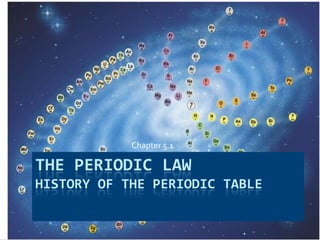Chapter 5.1 : History of the Periodic Table
•Transferir como PPTX, PDF•
3 gostaram•3,432 visualizações
Denunciar
Compartilhar
Denunciar
Compartilhar

Recomendados
This presentation was provided by William Mattingly of the Smithsonian Institution, during the third segment of the NISO training series "AI & Prompt Design." Session Three: Beginning Conversations, was held on April 18, 2024.Mattingly "AI & Prompt Design: The Basics of Prompt Design"

Mattingly "AI & Prompt Design: The Basics of Prompt Design"National Information Standards Organization (NISO)
Mais conteúdo relacionado
Mais de Chris Foltz
Mais de Chris Foltz (20)
Último
This presentation was provided by William Mattingly of the Smithsonian Institution, during the third segment of the NISO training series "AI & Prompt Design." Session Three: Beginning Conversations, was held on April 18, 2024.Mattingly "AI & Prompt Design: The Basics of Prompt Design"

Mattingly "AI & Prompt Design: The Basics of Prompt Design"National Information Standards Organization (NISO)
This presentation was provided by William Mattingly of the Smithsonian Institution, during the fourth segment of the NISO training series "AI & Prompt Design." Session Four: Structured Data and Assistants, was held on April 25, 2024.Mattingly "AI & Prompt Design: Structured Data, Assistants, & RAG"

Mattingly "AI & Prompt Design: Structured Data, Assistants, & RAG"National Information Standards Organization (NISO)
APM Welcome
Tuesday 30 April 2024
APM North West Network Conference, Synergies Across Sectors
Presented by:
Professor Adam Boddison OBE, Chief Executive Officer, APM
Conference overview:
https://www.apm.org.uk/community/apm-north-west-branch-conference/
Content description:
APM welcome from CEO
The main conference objective was to promote the Project Management profession with interaction between project practitioners, APM Corporate members, current project management students, academia and all who have an interest in projects.APM Welcome, APM North West Network Conference, Synergies Across Sectors

APM Welcome, APM North West Network Conference, Synergies Across SectorsAssociation for Project Management
Último (20)
Mattingly "AI & Prompt Design: The Basics of Prompt Design"

Mattingly "AI & Prompt Design: The Basics of Prompt Design"
ICT Role in 21st Century Education & its Challenges.pptx

ICT Role in 21st Century Education & its Challenges.pptx
Z Score,T Score, Percential Rank and Box Plot Graph

Z Score,T Score, Percential Rank and Box Plot Graph
Mattingly "AI & Prompt Design: Structured Data, Assistants, & RAG"

Mattingly "AI & Prompt Design: Structured Data, Assistants, & RAG"
Beyond the EU: DORA and NIS 2 Directive's Global Impact

Beyond the EU: DORA and NIS 2 Directive's Global Impact
Ecological Succession. ( ECOSYSTEM, B. Pharmacy, 1st Year, Sem-II, Environmen...

Ecological Succession. ( ECOSYSTEM, B. Pharmacy, 1st Year, Sem-II, Environmen...
SECOND SEMESTER TOPIC COVERAGE SY 2023-2024 Trends, Networks, and Critical Th...

SECOND SEMESTER TOPIC COVERAGE SY 2023-2024 Trends, Networks, and Critical Th...
Presentation by Andreas Schleicher Tackling the School Absenteeism Crisis 30 ...

Presentation by Andreas Schleicher Tackling the School Absenteeism Crisis 30 ...
Unit-IV; Professional Sales Representative (PSR).pptx

Unit-IV; Professional Sales Representative (PSR).pptx
APM Welcome, APM North West Network Conference, Synergies Across Sectors

APM Welcome, APM North West Network Conference, Synergies Across Sectors
Chapter 5.1 : History of the Periodic Table
- 1. The Periodic LawHistory of the Periodic Table Chapter 5.1
- 2. Objectives Explain the roles of Mendeleev and Moseley in the development of the periodic table. Describe the modern periodic table. Explain how the periodic law can be used to predict the physical and chemical properties of elements Describe how the elements belonging to a group of the periodic table are interrelated in terms of atomic number.
- 3. Early History By 1860 – more than 60 elements had been discovered. September of 1860 – First international Congress of Chemists met Cannizzaro – convincing method for measuring relative atomic mass Became a standard for showing relationship between atomic mass and properties of elements Stanislao Cannizzaro
- 4. Mendeleev and Periodicity Russian Chemist – Dmitri Mendeleev First usable periodic table Arranged according to : 1. Properties 2. Atomic mass Interesting facts: 1. Some Atomic masses were out of place 2. Empty spaces for elements not yet discovered. Later they were and fit right in.
- 5. Moseley and Periodic Law 1911 – Henry Moseley Working with spectra of 38 metals – elements fit into better patterns when organized according to nuclear charge. Led to : Modern definition of atomic number Periodic table organized according to atomic number instead of atomic mass Periodic Law : The physical and chemical properties of the elements are periodic functions of their atomic numbers.
- 6. The Modern Periodic table Define: arrangement of the elements in order of their atomic number so that elements with similar properties fall in the same column, or group.
- 8. 1900 – Friedrich Dorn discovered Rn
- 9. Placed this new group of elements in a new group
- 12. Thorium to Lawrencium ( Bottom row – f-block)
- 13. To save space – both were set off below main portion of periodic table
- 15. Periodic Table songby Tom Lehrer There’s antimony, arsenic, aluminum, selenium, And hydrogen and oxygen and nitrogen and rheniumAnd nickel, neodymium, neptunium, germanium, And iron, americium, ruthenium, uranium, Europium, zirconium, lutetium, vanadium And lanthanum and osmium and astatine and radium And gold, protactinium and indium and gallium And iodine and thorium and thulium and thallium. There’s yttrium, ytterbium, actinium, rubidium And boron, gadolinium, niobium, iridium And strontium and silicon and silver and samarium, And bismuth, bromine, lithium, beryllium and barium. There’s holmium and helium and hafnium and erbium And phosphorous and francium and fluorine and terbium And manganese and mercury, molybdinum, magnesium, Dysprosium and scandium and cerium and cesium And lead, praseodymium, platinum, plutonium, Palladium, promethium, potassium, polonium, Tantalum, technetium, titanium, tellurium, And cadmium and calcium and chromium and curium. There’s sulfur, californium and fermium, berkelium And also mendelevium, einsteinium and nobelium And argon, krypton, neon, radon, xenon, zinc and rhodium And chlorine, cobalt, carbon, copper, Tungsten, tin and sodium. These are the only ones of which the news has come to Harvard, And there may be many others but they haven’t been discovered.